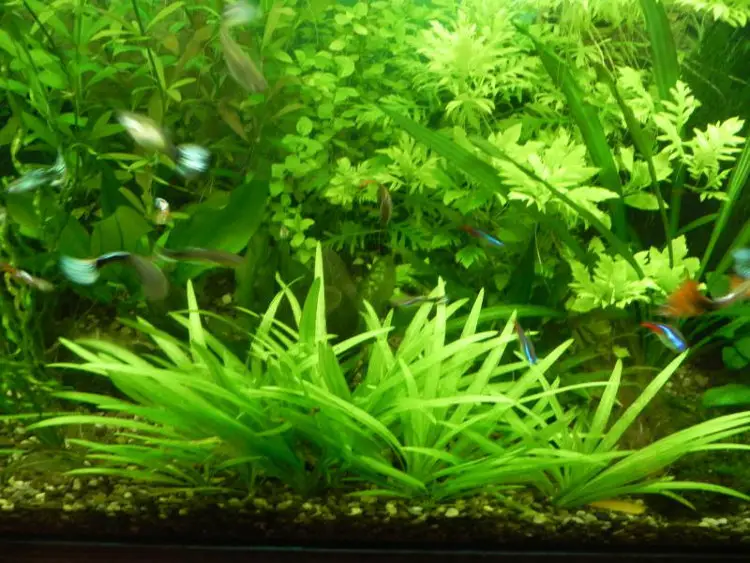Echinodorus quadricostatus is a member of the Alismataceae family. A small, fast-growing aquarium and tank plant is distinguished by long leaves of light green color, which in a short time form extensive thickets and stand out among the darker varieties. The size of the bush depends on the quality and duration of the lighting. The variety decorates the middle and foreground of aquariums, suitable for cultivation in paludariums.

Echinodorus quadricostatus belongs to the Alismataceae family.
Table of Contents
Echinodorus Quadricostatus ORIGIN AND DESCRIPTION
The natural habitat of Echinodorus Quadricostatus (four-ribbed) is the water bodies of Brazil and other South American countries. In some specialized stores it is found under the erroneous name Bolivianus var. magdalenensis.
The plant stands out with short cuttings and thin, elongated up to 15-20 cm leaves of a mint shade up to 0.5-0.7 cm wide. The height of the green bush reaches 10-20 cm, depending on the water temperature and the brightness of the lighting fixtures. To form a large spreading plant (up to 30 cm in height), all daughter layers are regularly cut off.
The growth of the subspecies is rapid. The specimen is capable of releasing young shoots every day. Decorates large and small containers with a thick grass carpet. Single plantings are grown in small aquariums. Coarse pebbles are used to limit the growth of multiple cuttings.
Echinodorus Quadricostatus plant care in aquarium
Echinodorus is a hardy and undemanding plant to care for.
The size and rate of its growth are controlled by the following parameters:
- Lighting. Echinodorus develops in both intense and dim light. In the shade, the leaves are drawn to the light source, so large single specimens up to 20 cm grow. In bright light, the bushes multiply faster and spread along the bottom in dense thickets. Like many aquarium plants, Quadricostatus prefers combined fluorescent and LED lighting fixtures. To achieve the desired result, the brightness of the backlight is adjustable. The optimal daylight hours are 9-12 hours. Recommended lighting is 0.4-0.5 W / l.
- Water. Acceptable water temperature for the content of the subspecies is + 21 … + 28 ° C, the average degree of hardness is 8-15 ° F, the acidity level (pH) is 6.5-8.5. Hard water inhibits growth, soft water leads to iron deficiency without regular feeding. A weekly replacement of part of the water in the tank is required, filtration is required.
- Substract. For the base, it is recommended to use fine gravel or coarse river sand. In silted soil for an aquarium, the plant develops faster. Quadricostatus needs additional nutrient support with iron more than other Echinodorus species. The most important is the enriched substrate during the start-up period of the aquarium.
- Fertilizer. Echinodorus Quadricostatus develops without auxiliary nutrients, but when they are deficient, the plant fades, the color fades. Regular application of CO2 in the ratio of 3-5 mg per 1 liter of water has a beneficial effect on the development of the population. It is recommended to feed Echinodorus with a complex of macro- and microelements in liquid form, use sub-root tablets. In the absence of a substrate containing iron, the trace element is applied in the form of a liquid fertilizer.
For an aesthetic look, the bushes are planted in groups in a checkerboard pattern. The plant loves the first or middle line. The thickets do not impede the feeding of the fish, the stuck food does not harm the growth of foliage.
propagation of Echinodorus Quadricostatus
Propagation and reproduction of Echinodorus is carried out by separating the lateral creeping processes from the uterine root system. The distance from the new plants to the mother bush is 45-50 cm. Young layers are formed 2-6 cm from each other and after 2 months they develop to full size. There is not enough space in the vessel for the rooting of new representatives, and they germinate above the old ones, releasing their roots.
The second way is to divide the suitable socket into 2 halves.
With seed reproduction, a large percentage of seeds do not germinate or crops die in the first months. A long time is required for the development of a seedling into a bush. This method is not recommended for home use.
In its terrestrial form, Echinodorus is bred in high humidity greenhouses.